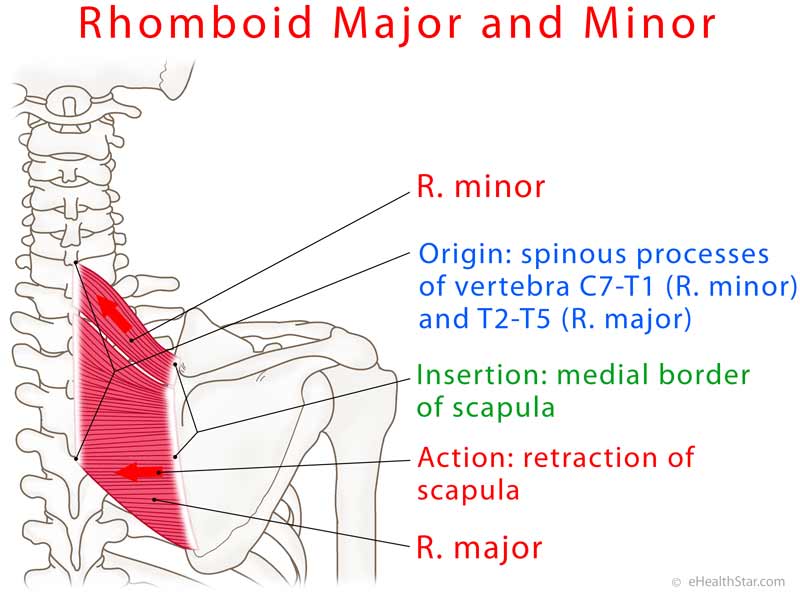Rhomboid Muscles Location
Rhomboid major and minor are shoulder muscles that extend from the thoracic part of the vertebral column to the medial border of the shoulder blade (scapula). They lie beneath the trapezius muscle.
Origin
- Rhomboid major originates from the spinous processes of the vertebra T2-T5 [1].
- Rhomboid minor originates from nuchal ligament and spinous processes of C7-T1 [1].
Insertion
- Rhomboid major inserts to the part of the medial border of scapula above the spine of the scapula.
- Rhomboid minor inserts to the part of the medial border of scapula below the spine of the scapula.
Functions (Actions)
Rhomboid major and minor [1]:
- Retract the scapula (bring it closer to the spine)
- Rotate the scapula, which results in the elevation of the middle border and depression of the lateral angle of the scapula and thus shoulder (glenohumeral) joint
- Fix the scapula to the chest wall
Innervation
Rhomboid major and minor are innervated by the dorsal scapular nerve that arises from the spinal nerve roots C4 and C5.
Blood Supply
Rhomboid major and minor get blood via the dorsal scapular artery.
a
Picture 1. Rhomboid major and minor anatomy:
origin, insertion, action
Rhomboid Major or Minor Spasm, Strain or Tear
Rhomboid major or minor spasm can result from repeated carrying of a heavy backpack over one shoulder. A strain can result from reaching for something on a high shelf. A tear can occur in sports with frequent shoulder use, such as golf, tennis, rowing, rock climbing and gymnastics [2].
Symptoms include sudden sharp pain, tenderness and swelling between the shoulder blade and spine, usually on one side [2]. The pain can be aggravated by shoulder movements, like shrugging.
Rhomboideus Strength Test
You lie face down and extend both arms sideways. Lift the affected arm against the examiner’s arm (Video 1). Pain and decreased strength during the movement–when compared to the opposite side–speaks for a rhomboid muscle injury.
Video 1. Rhomboideus strength test
The tear can be confirmed by a magnetic resonance imaging (MRI).
Treatment
Treatment of muscle spasm includes avoiding carrying backpacks and shoulder overuse and applying moist heat over the affected area few times a day [2].
Treatment of muscle strain includes [2]:
- Rest from the painful activities
- Ice packs several times a day in the first 48 hours
- Anti-inflammatory drugs, such as aspirin or ibuprofen to reduce swelling
- Rehabilitation with stretching exercises as recommended by a physiotherapist
Recovery time for rhomboid muscle strain or tear is 3-6 weeks [2].
- References
- Rhomboid major and minor University of Washington, Department of Radiology
- Rhomboid strain or spasm Summit Medical Group


